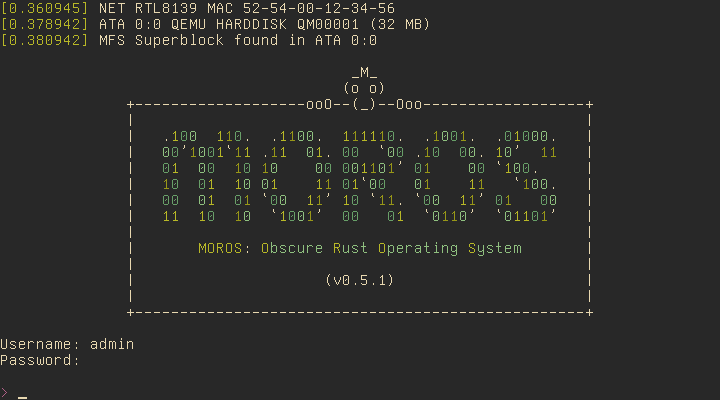* Add write to FUSE driver * Update code * Fix file creation * Remove debug print * Remove more print statements * Remove unsupported function * Fix entries * Allocate space for new dir entry * Fix dir block size computation * Add unlink * Refactor private methods * Remove debug operation |
||
|---|---|---|
| .cargo | ||
| .github | ||
| doc | ||
| dsk | ||
| run | ||
| src | ||
| www | ||
| .gitignore | ||
| .static | ||
| CHANGELOG.md | ||
| Cargo.lock | ||
| Cargo.toml | ||
| LICENSE | ||
| Makefile | ||
| README.md | ||
| rust-toolchain.toml | ||
| x86_64-moros.json | ||
README.md
MOROS: Obscure Rust Operating System
MOROS is a hobby operating system written in Rust by Vincent Ollivier.
It targets computers with a x86-64 architecture and a BIOS, so mostly from 2005 to 2020, but it also runs well on most emulators (Bochs, QEMU, and VirtualBox).
This project started from the seventh post of the second edition of Writing an OS in Rust by Philipp Oppermann and by reading the OSDev wiki along with many open source kernels.
Features
- External bootloader (using bootloader)
- x86 CPU support (using x86_64)
- Hardware interrupts (using pic8259)
- PS/2 Keyboard with customizable layout (using pc-keyboard)
- VGA Text mode with customizable font and color palette
- Serial output (using uart_16550)
- Paging
- Heap allocation (using linked_list_allocator)
- ACPI shutdown (using acpi and aml)
- RTC clock
- PCI devices
- ATA PIO mode
- Random number generator (using rand_chacha)
- RTL8139 network card
- AMD PCNET network card
- DHCP/IP/TCP/UDP/DNS/HTTP network protocols (using smoltcp)
- Basic filesystem
- Basic shell
- Basic text editor
- Basic lisp interpreter
- Basic file and network commands
- Basic userspace for nasm binaries
- Support for Rust binaries
- Support for multitasking
- C standard library port
Documentation
Documentation is available here
Setup
Clone the repo:
$ git clone https://github.com/vinc/moros
$ cd moros
Install the required tools with make setup or the following commands:
$ curl https://sh.rustup.rs -sSf | sh
$ rustup install nightly
$ rustup default nightly
$ cargo install bootimage
Usage
Build the image to disk.img:
$ make image output=video keyboard=qwerty nic=rtl8139
Run MOROS in QEMU:
$ make qemu output=video nic=rtl8139
Run natively on a x86 computer by copying the bootloader and the kernel to a hard drive or USB stick (but there is currently no USB driver so the filesystem will not be available in that case):
$ sudo dd if=target/x86_64-moros/release/bootimage-moros.bin of=/dev/sdx && sync
MOROS will open a console in diskless mode after boot if no filesystem is detected. The following command will setup the filesystem on a hard drive, allowing you to exit the diskless mode and log in as a normal user:
> install
Be careful not to overwrite the hard drive of your OS when using dd inside
your OS, and install or disk format inside MOROS if you don't use an
emulator.
Tests
Run the test suite in QEMU:
$ make test
LICENSE
MOROS is released under MIT.


